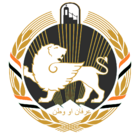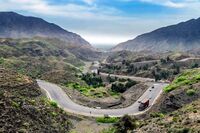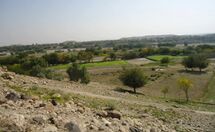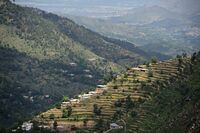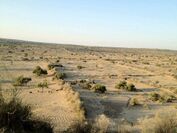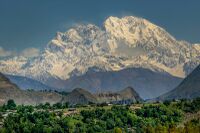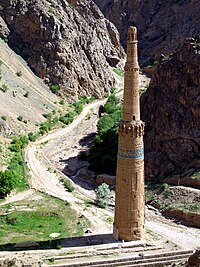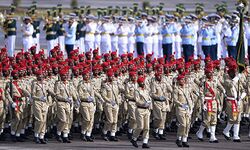Gulbistan
This article is incomplete because it is pending further input from participants, or it is a work-in-progress by one author. Please comment on this article's talk page to share your input, comments and questions. Note: To contribute to this article, you may need to seek help from the author(s) of this page. |
Federation Of Gulbistan | |
|---|---|
| Motto: عرفان او وطن "Erfān aw Watan"
"Irfan and Homeland" | |
| Anthem: خدای ته وقف شوی | |
Location of Gulbistan(dark blue) in Coius(light blue) | |
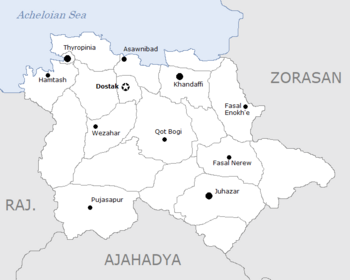 | |
| Capital | Dostak |
| Largest City | Thyropinia |
| Official languages | Mershi |
| Recognised regional languages | Abali and others |
| Demonym(s) | Gulbistani |
| Government | Federal Presidential Republic |
• President | Omar Sherzai |
| Legislature | Federal Congress |
| Tribal Jirga | |
| People's Jirga | |
| Establishment | |
• Independence | 1946 |
• Federation Established | 1995 |
| Population | |
• 2020 census | |
| GDP (PPP) | 2020 estimate |
• Total | |
• Per capita | $4,519.87 |
| GDP (nominal) | 2020 estimate |
• Total | |
• Per capita | $4,375.99 |
| Gini (2020) | 41.5 medium |
| HDI (2020) | 0.642 medium |
| Currency | Wazen (WZN (وزن)) |
| Time zone | UTC-2 (UTC) |
| Date format | dd.mm.yyyy |
| Driving side | right |
| Calling code | +109 |
| Internet TLD | .gb |
Gulbistan (Mershi: ګلبستان; Gulbistān ), officially the Federation Of Gulbistan (Mershi: د ګلبستان فدراسیون; Da Gulbistān Federāsion): is a Federal Presidential Republic located in northeast Satria on the continent of Coius. It is bordered by Rajyaghar to the west, Ajahadya to the south, and Zorasan to the east.
Gulbistan was settled by humans over 60,000 years, but the first major settlement was the ancient city of Amtes, today known as Hamtash. By the year 2500BC Satro-Eucleans arrived in the region from the east, and dominated the region. Amstia would be the largest of several small states that were built on being trade hubs between Satria, Rahelia, and Euclea. Ancient Piraeans even settled and founded numerous settlements on Gulbistan's shores, the largest being the city of Thyropinia, which eventually became its own state that would mix with Amstians and other ancient peoples until their fall. The ancient Amtsians would eventually be conquered by early Pardarian Heavenly Dominions and would Gulbistan would be turn into a land inhabited by the Pardarians people. The region would also be settled by Togotis and Satrians during this period and resulted in the rise of a multilinguistic and multicultural society arose. The Pardarians would rule over Gulbistan until the Mershi Pafdaris invaded from the mountains and conquered most of modern Gulbistan. The Mershi would become the dominant ethnic group. The Pardarians reconquer Gulbstian under the Third Dominion, but after its collapse the Rahelian-Mershi Muhab tribe would take control of the power vacuum left and formed the Muhabid Empire, who would eventually be overthrown by a tribe native to Khandaffi who formed the Khandaffid Empire.
During the 16th century, the Khandaffid Empire was invaded by the Togoti Khaganate. The Togotis would rule the region until its split, when Gulbistan became part of the Khardarid Khanate. During there rule many Mershi clerics and scholars began the groundwork for Mershi nationalism, promoting a Mershi-based independence movement. This independence would eventually come in 1706 with the Zemani Uprising and the capture of the Dostak Fortress, this would establish the Zemani Empire. The Zemani Empire grew slowly at first, but would eventually form an unlikely relationship with Paretia, who would supply the Zemani with Euclean weaponry and military advisors in turn for trading and commercial control as well as the selling of Thyropinia to Paretia. The Zemani would expand across Gulbistan and find itself in conflict with all of its neighbors. They would specifically target the Naratha Confederacy of modern-day Rajyaghar. A series of bloody wars between the two would weaken Gulbistan as well as the dwindling support from Paretia and the rise of Etrurian influence. The Zemani Empire would also establish Edgamic Law, in which the non-Mershi peoples of Gulbistan were tobe assimilated into the dominant culture as well, it also promoted literacy and Irfan. Gulbistan would eventually fall to Etrurian colonial rule in 18XX and would be transformed into the Dominion Of Galbaterra. During Etrurian rule, the Mershi ruling class would continue to propogate Edgam with very little intervention.
During the Great War, Gulbistan would be swept with ideas of independence, and so several independence groups arose and allied with the Ajahadyans during the war. During the Great War, the Spear Of Khoda, Wolekhoda, and Gulbi State Army. However, with Etruria winning the war, Gulbistan would remain Etrurian for another decade. During the Solarian War, The SOK and GSA would lead rebellion with the support of many nations. The SOK would be given support by the CN and in particular Paretia, and the GSA would become the Gulbistani wing of the Green Pardal movement during the war. The Provisional Government of Gulbistan would be formed by the resistance forces and they would partake in the First Satrian War as well as small conflicts with Ashkezar in the east to take whatever they could. After, the Emirate Of Gulbistan would be formed with the help from CN and Paretian advisors and Ishmael Khurnan would be made Emir while the SOK's leader Hasir Zalmeh would be the first Prime Minister. The Emirate was unstable and numerous forces influenced policy and its rushed formation led to widespread corruption. Former GSA members would begin a small anti-government movement that would grow over time. In 1959, the Emir would be overthrown by former GSA members led by Pason Paywastun, who would establish the Republic Of Gulbistan. Paywastun would force Paretia to return Thyropinia in the Thyropinian Crisis of 1959. The Republic would reform much of Gulbistan but would lose popularity in the 70s and 80s due to secular laws being passed, which eventually led to the rise of the Gulbistani Tribal Confederation and conflict would intensify into the Gulbistani Civil War, which would last from 1985 to 1995 and led to the establishment of Gulbistan's modern government.
Gulbistan would slowly recover form the war during the 90s and the new leadership would be opposed by many minorities, especially those in Tobadad and Abalistan, leading to the Tobadad and Abalistan Insurgency which began to rise in 2000. This new threat along with slow economic recovery would lead to the rise of the GNP and Omar Sherzai, who would become president in 2007 and has remained president ever since. In 2017, the National Assembly have agreed to give Sherzai emergency powers due to the rise in insurgencies in Tobadad, leading to him effectively becoming president for life until the situation is over. Between 2004 and today, the Gulbistani economy saw a massive boom due to the new relationship forged with COMDEV and Senria after the civil war .
Today, Gulbistan is a growing nation with an economy that has been rising since the turn of the century. It is considered by many to be a Southern democracy or a flawed democracy due to the vast power of the presidency and the massive focus on military spending and economic stability. Gulbistan is a nation heavily dominated by Mershi culture, although there is still a massive population of other ethnic groups across the country. Gulbistan is also a member of COMDEV, Irfanic Cooperative Conference, and the Community of Nations.
Etymology
The name "Gulbistan" was first used in the era of the Pafdari Dynasty. The "stan" part of the name is derived from the Pardarian suffix "ستان" -stan, meaning "land of". The term "Gulbi" is most widely believed to be derives from the Pardarian words "گل" Gul, meaning flower, and "اب" Ab, meaning water. The term "Gulabi" has been seen in medieval Pardarian and Mershi texts to describe the region. Another common theory is the belief it comes from the Mershi word for pink, "ګلابي" Golabi, for the pink poppy plants that are commonly found in the mountains.
History
Prehistory
-Satro-Eucleans settle region
Antiquity
-Pardaric Hazho(NOTScythians/Sakas!) Steppe Culture and Satrians settle Gulbistan
-Tagamic peoples push Hazhos north, subsequent expulsion of Satrians in the Pakjir Lowlands.
-Amstian, Esuvian, and Sadanian Culture
-Piraean Settlement, Amstians expand their cultural influence
-Irfan arrives with First Dominion
-Satrians from Tobadad form multicultural Akanlid Dynasty
-Second Dominion Conquers Gulbistan
Medieval Period
-Pardarian Settlement
-Mershi Culture
-Hunzad Empire
-Pafdari and Thyropinian Sultanates
-Pafdari Sultanate
-Third Dominion Conquers Gulbistan
-Rahelian Muhabid Dynasty take over, Muhabid Empire
-Khandaffi nobles establish their own nation, war ends with Khandaffid Victory, Khandaffid Sultanate
Togoti Invasions
-Togoti Empire invades Khandaffid Empire
-Togoti splits, Gulbistan becomes part of the Khardarids
-Zemani Clan leads Mershi rebellion against Khardarids and succeeds
Zemani Empire
-Zemani Empire established, quick expansion across Gulbistan
-Zemani sell Thyropinia and trade rights to Paretia in turn to military support in their wars
-Zemani Empire expands into neighboring regions, namely Rajyaghar(Naratha), Pardaran(Gorsanids), and Ajahadya.
-Mershi assimilation law put in place
-First period of modernization
-Etrurian influence begins to rise as Paretians lose power in region
Colonization
-Etruria colonized the Zemani Empire and establishes the Dominion of Galbaterra
-Clergy becomes a powerful upper class during this period and promote Mershi assimilation and nationalist ideologies
Great War and Solarian War
-SOK is formed and attempts a revolt against Eturia
-Alliance wins the war and SOK goes underground
-SOK, WK, and GSA rebel again during the Solarian War
-Resistance forces win, provisional government formed with CN and Paretian support, SOK takes leadership
-Gulbistan loses territory to Satrians during the First Satrian War, but keep Tobadad and Dakpesh
Emirate
-Ishmael Khurnan becomes Emir of Gulbistan, SOK leader Hasir Zalmeh becomes first PM
-Emirate corrupt and quickly spirals into goverment chaos with PMs growing in power and weak Emirs
-Widespread corruption leads to protests and riots in the cities
-Former GSA members led by Pason Paywastun lead coup against Asfand Emir
Republic
-Leftist government established, Republic of Gulbistan formed by Pason Paywastun and GSA
-Paretians refuse to give up Thyropinia, Paywastun surrounds the city with military forces and riots widespread, Thyropinian Crisis, Paretians give in
-Early Republic under Paywastun modernizes Gulbistan and expands Gulbistan's influence in Satria and Western Coius, ideologically aligned with Sattarists in Pardaran and Khazestan. Infrastructure and modernization.
-Possible war with Rajyaghar????
-Paywastun grows older, Gulbi Social Party divided between Irfanic Socialists and Progressives. Progressive Turan Wassan-Hassan becomes PM and makes liberal changes as well as secular law, Gulbistan begins to align with Kirenians. (Progressive victory spurred by defeat in possible war with rajyaghar?)
-Irfanic leaders along with businessmen and other groups begin to ally and form the Gulbistani Tribal Confederation, and civil war begins in 1985
-War intensifies after years of conflict, cities such as Khandaffi and Juhazar are major battlegrounds as rebels begin organizing into a formidable military force
-Satrians in Tobadad attempt to split off, both Republic and Rebel forces invade Tobadad to stop the Satrian independence movement
-War ends with the surrender of Republican Forces in 1995
Modern Gulbistan
-Gulbistan is turned into the Federation Of Gulbistan under the leadership of Darwish Wajia
-Early Federation is focused on rebuilding after a decade of war, but the slowness of this and rise of minority insurgencies leads to the fall of Wajia's popularity
-Gulbistani National Party becomes popular and claims to be the ones to rebuild Gulbistan, which is true to an extent
-Early 2000s Gulbistan starts to recover from the war under the leadership of Aziz Shah-Khan and economy starts to boom
-Insurgencies intensify, leading to Shah-Khan falling out of power and the rise of Omar Sherzai
-2007 Sherzai is elected, begins a massive military operation in Tobadad and Abalistan to defeat rebel forces
-Sherzai begins a more economically liberal policy and opens up Gulbistan to more foreign investors, namely Senrians
-Sherzai joins COMDEV in 2010
-Sherzai is given emergency powers and effectively cancels elections until 2022.
Geography
Climate
Biodiversity

Much of Gulbistan's fauna includes large carnavores such as snow leopards and Gilustani Tigers. The mountainous terrain of the Basht Tabriks and Pavitras(Pafdari) are also home to numerous species of goats and related animals, including the national animal, the Loya Markhor. Gulbistan is home to numerous different species native to the country, including the Gulbi Flying Squirrel and the Basht Tabrik Finch. The Gulbi Hound is a dog breed native to the mountains of Gulbistan and has come a popular breed of dog throughout the world. Other common species found on land include foxes, hedgehogs, wild sheep, mongooses, hyenas and deer. Satrian elephants are also found in the northern lowlands on rare occasion.
Government and Politics
Gulbistan today is a Federal Presidential Republic where a President is both head of state and head of government. The government's structure is laid out in the Constitution Of The Grand Jirga written in 1995. Its government contains an executive brance, legislative, and judicial branch. Federalism in Gulbistan is engrained into the constitution due to the need for local autonomy of the tribes and the minority groups that inhabit the country.
Government
The executive branch of the government is led by the president, who holds both roles of head of government and head of state as well as being the commander-in-chief of the Military Forces Of Gulbistan. He is responsible for foreign policy, as well as appointing ministers into office. The job of the president is to execute laws, maintain foreign relations, and serve the role as commander-in-chief of the Gulbistani Defense Forces. The Gulbistani Cabinet of Ministers has several different ministers with roles ranging from foreign policy and defense. Ministers are typically appointed directly by the president and do not need approval from the Federal Congress of Gulbistan, however, the Federal Congress is able to hold a vote of no confidence against any of the ministers at any time. The president is typically elected every two years, with no term limits. However, presidential elections have been suspended since 2017 after the Federal Congress gave emergency powers to the current president, Omar Sherzai, due to a rise in attacks from insurgents in Tobadad and Abalistan.
The legislative branch of government has the Federal Congress of Gulbistan, which contains an upper and lower house. The role of the Federal Congress is to propose and pass law that are then sent to the president for approval. A bill must go through both houses with a majority vote to reach the president. A president's veto can be overturned if the upper house votes over 1/2 in favor and the lower house votes 3/4 in favor. The lower house, the People's Jirga, has 316 in which each seat represents a district of rougle 200,000 people. Any person can run for office in the People's Jirga. The upper house, the Tribal Jirga, has 200 seats. Each province has 20 seats in the Tribal Jirga, and each member of the Tribal Jirga must be a prominent member of their local society, they must be a man who owns property and has a family.
Political parties
Law and Judiciary
Demographics
According to the Gulbistani Census, the nation of Gulbistan has a population of 64,992,804 in 2020. The Gulbistani population has grown dramatically, and has seen an explosion since the 1970s. The city of Thyropinia alone has a population of over 4 million, and is one of Satria's largest growing urban centers. The capital, Dostak, also has seen the same exponential growth alongside Thryopinia. The population boom has been throughout every region of Gulbistan, however, the population of the northwestern lowlands has seen the most growth as well as an increase in urbanization and the growth population densities in nearly every city in Gulbistan. Around 70% of the Gulbistan's population lives north of Wezahar, and that percentage grows every year.
Ethnic
Gulbistan is mostly a Mershi nation, but it also has large and influential minorities. In Gulbistan, most groups descend from the Pardaric or Satric peoples, with the notable exceptions of the Asepistani and Togotis. The Mershi make up over 70% of the Gulbistani population, and form the largest ethnicity in the nation. The other Pardaric ethnicities that make up Gulbistan include the Abali and Buzdari, with the Abali being Gulbistan's second largest ethnic group. Gulbistan is home to a large number of Satrians, these include the Zulmati, Zubadi, and Sindhi peoples.
Gulbistan is home to dozens of minor ethnic groups, although their numbers range only from the hundreds to thousands. These include the Dabra, the Pahideli, and numerous other small ethnic groups. These groups mostly live in the Basht Tabrik mountains or the Great Steppe. Since the 1700s, these small ethnic groups have dwindled in size and in nearly 30% of the languages in Gulbistan in 1920 have gone extinct by 2000. Much of this is due to the Mershi policy of Edgam during the Zemani and colonial eras and the policy of modernization during the 20th century. Most of these small ethnicities have assimilated partially or entirely into the dominant Mershi culture, although groups like the Pahideli have remained relatively unchanged throughout the decades.
Languages
Gulbistan's official language is Mershi, which has maintained a status of lingua franca since the era of the Khandaffid Empire. Gulbistan is also home to numerous other Satro-Euclean languages, with the Satrian languages being more predominant in the west. Sindhi, Zubadi, and Matrabashi are the three main Satrian languages spoken in Gulbistan, with Matrabashi being spoken in westerm Hamsha, Sindhi! being spoken in Dakpesh and western Pafdaris, and Zubadi being spoken in Tobadad. The other major language group is the Pardarian languages, which includes Mershi, Abali, and Buzari and numerous smaller languages. These languages make up the vast majority of the nation and are spoken in the central and western regions. There is also the Togoti and Asepistani languages that do not belong to either group, but also make up a significant size and are spoken in the south and southeast.
Vespasian and Luzelese are also languages that are common in Gulbistan. Luzelese is most widely seen in Thyropinia due to Paretian colonization of city, but has seen a strong dwindle in usage since decolonization. Vespasian is more common in other cities and has seen a resurgence since the 2000s due to many officials seeing at a future lingua franca in the country due to the refusal of many to learn Mershi. Vespasian is a secondary language for around 30% of the population, mostly hailing from the northern cities such as Dostak, Asawnibad, and Hamtash. Vespasian's modern-day usage is mostly used for reading old street signs as well as communicating with foreign tourists from Etruria and former Etrurian colonies.
Religion
Irfan is the predominant religion of Gulbistan, of which 93% of the nation's population adhere. Irfan has been Gulbistan's predominant religion for nearly two millennia, and plays an important role in every day life, politics, and the societal structure of Gulbistan. Hasawi is the predominant form of Irfan found in Gulbistan, with Asha only making up 25% of the population. Gulbistan is also home to a unique branch of Irfan called Jaghundi Irfan. Ashram and Tulyata are Gulbistan's two second largest religions, both collectivelly taking up 6% of the national population. Both are worshiped almost excusively by Satrians, mainly in the rural areas of Dakpesh, Tobadad, and Western Hamsha. Ashram is predominantly found in the north while Tulyata is found across the south along the border with Ajahadya. Other religious minorities in Gulbistan include Sotirians, of which most reside in the Deh Sotir district of Thyropinia. Badi can be found in the southeastern steppes and is worshipped mostly by nomadic tribesmen and a few families of Togotis. Other smaller groups include a few irreligious people and Zohists.
Subdivisions
Gulbistan is divided up into 20 different subdivisions, with 12 Provinces, 4 Autonomous Regions, 2 National States, and 2 Urban Districts. These subdivisions are divided into levels of autonomy. Provinces are the most basic level of government, they are subject to the original rules of the 1995 Jirga. Autonomous regions were created in 2005 and are granted certain levels of autonomy from the federal government, namely for cultural purposes such as holidays and government purposes such as the structure of regional legislatures. National states were created in 2017 and include the states of Tobadad and Abalistan. These regions are subject to minor autonomy, but are put under military control as their State governor is appointed by the President. The reason for this change was the rise in insurgent presence the mounting evidence of regional cooperation with insurgents, leading to military leadership in the regions. The final type are urban districts, of which are the Thyropinia Urban District and Dostak Urban District. These districts have slightly less autonomy than provinces but are relatively the same other than the mayors of Thyropinia and Dostak are also immediately given leadership of the districts.
Cities
Culture
Gulbistani culture has no clear definition due to the nations' multiethnic nature, but a major influential Mershi-dominant shared culture does exist. Gulbistan has also been heavily influenced by both the cultures of Rahelia and Satria due to its vital location along trade routes between the regions. These influences along with Mershi cultural domination has defined modern Gulbistani culture, along with the strong influence of Irfan in everyday society and life. The Mershi people also still retain a tribal society with Mershiwali, still having usage in modern society, although due to years of modernization, the tribal structure has been integrated into the modern society, especially in the cities and northern lowlands. In the more rural areas tribal society still has a hold, but modernization has also played a role in almost entirely removing tribal conflict from society and focusing on conflicts with non-Mershi ethnicities. This tribal dichotomy has played a heavy role in the divison of Gulbistani society into Kuhar and Dashtar groups.
Kuhars and Dashtars
In 1910, Gulbistani writer Karlan Sabzvari coined the terms Kuhar and Dashtar in his book د ګلبستان ټولنه, Da Gulbistān Ṭolanah, or The Gulbistan Society in Estermish. According to Sabzvari, a Kuhar is man of the hills, one who does not care about issues beyond his family and community, and a man who follows Mershiwali perfectly. A Dashtar is a man of the city, a man who does not have time to focus on community and tradition, and follows most of the rules of Mershiwali. Since Sabzvari, the terms would gain initial popularity during the Great War. The resistance organization Da Neyze Khoda, would commonly use the term "Dashtar" to describe Gulbistanis who joined the Etrurian colonial government. The term would come to describe political divides of the north and south during the 1940s under the Emirate. After the Coup of 1959, the terms would be common in daily life. Kuhar would come to mean rural Gulbistanis who lived in the mountainous regions and small villages, while Dashtar came to describe a Gulbistani who was educated and lived in the cities or lowlands. During the Civil War, "Kuhars" would be the driving force behind the rebellion and the "Dashtars" would be split between support of the government and rebels. After the war, Kuhar and Dashtar became a common way of describing the political divide of modern Gulbistan with the Gulbistani National Party commonly being considered a "Dashtar party" and the Tribal-Irfanic Coalition a "Kuhar party". Modern definitions often include Irfan, believing that Dashtars are more secular and Kuhars are more Irfanic, although many other definitions refute this belief.
Festivals and Holidays
Art
Clothing
Architecture
Gulbistani architecture has its origins in ancient West Pardaric peoples but would first be widely seen in ancient Amtes. The city of Amtes would see the construction of many ancient structures which still stand today in Hamtash. Satrian architecture would be common throughout Gulbistan prior to Irfanic expansion. The Piraeans who would settle Thyropinia would have a small period of influence. All of these influences would conjoin during the multicultural era, in which religious syncrenism would greatly influence the religious architecture of Gulbistan. Today, Gulbistan's most famous structures include the Grand Minaret Of Jasha, The Mausoleum Of The Shah-Khan, Thyropinia Financial Tower, and the National Mazar.
Music
Classical Gulbistani music originates from Satrian and Pardarian musical influences. Irfan also plays a heavy role in folk music as many classic Gulbistani mucisians use their religion as a major part of their lyrics. Sufi! music is also very common and popular among Gulbistanis. Folk music is commonly played using a variety of instruments, the majority of which being strings, such as the harmonium and rubab. The rubab is a Mershi instrument used in Gulbistani folk music and is considered to be the most popular instrument in Gulbistani folk music.
Pop and rock music were introduced into Gulbistan during the early 1950s and become widely popular through newly established radio stations such as Dostak People's Radio, which rock becoming popular by anti-Emirate activists during the late 50s. These genres would lose steam until the 1970s when they saw a resurgence. These genres both incorporate elements of Gulbistani folk and classical with instruments and themes. The rubab is still widely used in pop and rock music along with many other classical instruments, which has created unique genres of music from Gulbistan known as Mershi pop and Mershi rock. Today, Mershi pop music has become Gulbistan's most popular genre with Gulbistani pop artists gaining traction in recent years with singers like Zmarak Banuchi and Anisa Bakhshi. Mershi rock today has seen a dip in popularity as foreign rock still remains more popular.
Cuisine
Gulbistani cuisine is based on the native crops of Gulbistan, with rice being the primary ingredient in most Gulbistani dishes. Other crops typically found include maize, wheat, barley, and melons. The national dish of Gulbistan, Mershi Waray Palaw, includes many of these ingredients and is seen a delicacy in Gulbistan and around the world. Beef and lamb are the most common meats used in traditional Gulbistani dishes, including the Palaw. Other major traditional foods commonly seen include yogurt, kebabs, and dumplings. Since the 1980s, Gulbistan also was introduced to fast food. Franchises and foreign establishments have opened across much of the northern lowlands, particularly in Thyropinia and Arghez.
Media
Gulbistani print media was first seen under the Etrurian colonial rule with the Vespasian and Mershi Dostacco Carta in 1894. The first Mershi-only newspaper would be created in the 1920 with Watan Warazpanrah. During the Great War papers became major propaganda lines for both the Etrurian colonial government, the Paretian colonial government, and the Gulbistani Resistance forces. During the Solarian War, the same would occur as the Spear Of Khoda and Gulbi Free Army both published newspapers promoting their cause, espcially to the tribesmen of the south.

